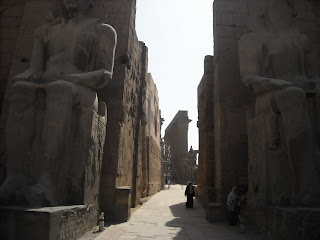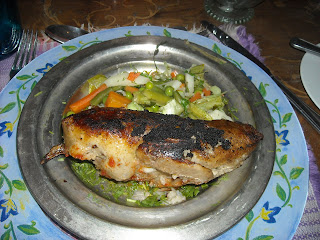
ANYWAY
Last Thursday AUC was closed for a new Egyptian holiday called “Taba Liberation Day,” which is used to mark the day Israel handed over the border town of Taba to Egypt in 1989 following a very long dispute. My friends and I decided to take advantage of the three-day weekend to travel, and so my friends Rachel, Dan, and I made the trek to Luxor and Aswan this weekend. These places, especially Luxor, which contains the Temples of Karnak and Luxor, are renowned worldwide for having the best preserved Ancient Egyptian artifacts and buildings in all of Egypt, and are places that everyone in Egypt should definitely try to see. We tried to make the trek before tourist season really kicked off, even though the places are full of tourists year round, and before the weather got unbearably hot since they’re towards the south of Egypt (closer to the Sudanese border than Cairo).
The trip started with an overnight train ride to Luxor that began at 8:30 PM and ended at around 6 AM (about 9 and a half hours). It wasn’t too bad since the seats were comfortable and I spent more or less the entire ride sleeping or at least attempting to do so. When we got off of the train, the first thing we did was find the cheap hotel I booked in advance, called the Nubian Oasis Hotel. On the inside I quickly noticed it was decorated with more posters of Bob Marley than a 16 year-old surfer’s bedroom, and it came as no surprise that we were offered hashish more than once while we were there (all of these offers were declined, no surprise to those that know me). While walking around town, I noticed that Luxor truthfully didn’t seem to have too much going for it other than the tourist sites, and I had read in guidebooks that the town is very heavily dependent on tourism. After a quick Egyptian breakfast of falafel, my friends and I hopped on a 1 LE (18 cent) microbus and got a ride to the Karnak Temple.

Karnak Temple from the outside
With the exception of the Pyramids at Giza, the Temple Complex at Karnak is the largest and most well-preserved remnant of Ancient Egypt, and has existed in some form or another since the 11th Dynasty of Egypt (2134-1991 BC). The temple complex is massive, and the part available to the public (The Temple of Amun) took us at least a couple of hours to see. From the giant obelisks and pylons covered in hieroglyphics to the dozens upon dozens of columns and pillars, everything one would expect in an Ancient Egyptian Temple was here. I took dozens upon dozens of pictures of the temple, which did not bode well for the rest of the trip as I was in the “well I already have 50 pictures of hieroglyphics and pillars” mindset. In short, I was glad I saw Karnak, as it was definitely one of those places everyone has to see in Egypt.


Karnak Interior
Our next stop was the Luxor Museum, which is smaller than the Egyptian Museum in Cairo, but at least was very well lit and labeled. It also had some of the most impressive and well-preserved statues I’ve seen, along with two rather creepy mummies with their faces unwrapped. Next stop was the famous Luxor Temple (built around 1400 BC), which is smaller and more straightforward than Karnak but an equally must-see attraction. Like Karnak, this Temple had hieroglyphics and pillars galore, but also randomly had a large Roman mural on the inside from the 3rd Century AD and a 13th Century Mosque built in the middle of the Temple. There was also a Temple caretaker that insisted on pointing out random hieroglyphics and also insisted on taking awkward pictures with us in order to not-so-subtly get a tip out of us. We relaxed for a while in the Temple’s large open courtyard (The Court of Amenhotep III), until what appeared to be a field trip from an Egyptian all-boys high school showed up and continuously approached us. This gave us our cue to leave, and we walked back to the hotel, stopping for fresh strawberry juice (note: freshly made juice in Egypt is amazing).


Some of Luxor Temple
For dinner, we ate at a classy-looking restaurant near our hotel where I finally got to order the Egyptian delicacy that is stuffed pigeon. While pigeons are viewed as flying rats in places like New York, they’re frequently farmed here and our shuttle bus from campus passes by people attracting pigeons to coops by waving flags (at least I think that’s what’s going on here). Pigeon meat actually tastes somewhat similar to dark meat on turkeys, only I don’t think I would order pigeon again since it’s such a chore to eat; there’s a ton of bones and relatively little meat.

Stuffed pigeon
The next day, we all set out on a tour arranged by our hotel that included the Valley of the Kings, the Temple of Hatshepsut, the Valley of the Queens, and the Colossi of Memnon. These sites are all located on the less-populated west bank of the Nile, and the tour allowed us to travel from one place to another without having to worry about cab fares and provided us with a guide. An important note about this day is that it was between 90-100 degrees out, so we all wore sunscreen and stayed in the shade whenever we could. Anyway, here’s the four sites summed up:
Valley of the Kings: Purchasing one ticket allows you to see any three tombs, with the exception of the Tomb of Tutankhamen that costs 100 LE extra (about $18) to see (50 LE for students). Our tour guide told us not to bother, since everything in the tomb is now in the Egyptian Museum in Cairo. I can’t recall the three exact tombs we visited, but all contained paintings that were incredibly vivid for being around 3000 years old. No photography was allowed inside of the tombs though, so you’re just going to have to take my word on this site (or google image “Valley of the Kings”)
The Temple of Hatshepsut: An imposing giant temple located more or less within a cliff that is dedicated to one of Egypt’s most famous female rulers. Some of the hieroglyphics in this Temple were still brightly colored, which I always find fascinating. On a not-so-bright side note, this is where the "Luxor Massacre" occurred in 1997 where 59 tourists were killed. Because of this attack however, terrorism in Egypt is extremely unpopular as it tends to scare away tourists, which in turn devastates the Egyptian economy.

The Temple of Hatshepsut, complete with tourists
The Valley of the Queens: Relatively similar to the Valley of the Kings, only we spent less time here as a ticket lets you see two tombs instead of three. The Tomb of Queen Nefertari is here, which is regarded as the most beautiful tomb in Egypt and apparently appears as if it was painted yesterday. However, to spend 10 minutes in this tomb costs 20,000 LE, or about $3500, so I don’t think I’ll ever see it in person.
The Colossi of Memnon: These are simply two giant (60 ft) seated figures of Amenhotep III that are on the side of one of the roads on the west bank of the Nile. While they’re not in the best condition since their faces are more or less gone, their size and the fact that nothing else is really around them makes them a very interesting sight.

The Colossi and I
So that was Day 2 of the trip, which concluded with a 3 hour train ride south to Aswan. On the train ride, we met a German woman that spoke perfect English and told us a lot of Aswan and Luxor’s features. Our first night at Aswan only consisted of finding a cheap hotel and getting feteer pizza for dinner (kind of like a quesadilla).
Aswan is a lot more friendly-looking than Luxor, as it has an impressive downtown area that isn’t too close to any tourist sites and has some beautiful views of the Nile at sunset (which we sadly didn’t get to see). We arranged a driver through our hotel again, which I’m sure was cheaper than taking a taxi everywhere for the day and was far easier. The first place we visited was the Aswan High Dam, which contains the Nile on one side and Lake Nasser, the World’s largest man-made lake on the other.

My friends and I on the Aswan High Dam
The next place we visited was Philae Island, which is reached by water taxi. The Island contains a sizeable Temple that was not originally there- it was originally in a space that is now underwater due to the first Aswan Dam. Tourists used to look at it underwater from boats, but between 1972-1980 the UNESCO moved the entire complex onto nearby Agilika Island. I have to say that for something that is over 2000 years old and was underwater for several decades, the Temple is in amazing shape and is very impressive.

The Temple of Isis on Philae Island
The next stop was a red granite quarry in Aswan, as apparently all of the red granite in Egypt comes from Aswan. The quarry contains a giant unfinished obelisk that would have been the largest in Egypt if it had been completely excavated, yet a flaw in the stone prevented this from occurring. We then took a very short water taxi ride to Elephantine Island, where we visited two small museums and a massive complex of ruins. However, my friends and I were the only tourists visiting at the time, which seemed unusual since every other site had been mobbed by tourists and this place seemed to contained a ton of history.

Some of the ruins on Elephantine Island
After seeing all of the sites one could see in Aswan during the course of a single day, we decided to take the train home since we had classes the next day. A first class train ticket would have cost us 170 LE, but we opted to buy second class tickets as they are only 60 LE a piece. The problem: foreigners aren’t allowed to buy second-class tickets at the station and can only buy them on the train. This worked out fine for us at first, as we all had seats in second class and were prepared for our 13 hour train ride back to Cairo. However, buying a train ticket on a train doesn’t mean you are guaranteed a seat (all train tickets have assigned seating when you buy a ticket at a station), and we found out on numerous occasions that we were indeed sitting in the assigned seats of other passengers. This caused us to move our seats at least twice as the train took on more and more passengers, and finally around midnight it appeared all of the seats on the train were taken. My friends and I found a spot in a very narrow corridor in the train’s café car and attempted to sit when we could….this didn’t really work though. On the plus side, I was sitting next to some very friendly Egyptian men that I spoke to completely in Arabic for quite some time and they complemented my speaking ability. In the end, if I am ever traveling with anyone that complains they are uncomfortable in the future…..

Egyptian friends and the corridor described







